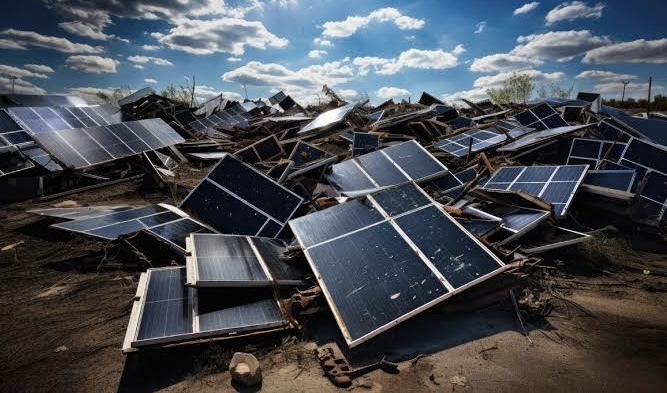The expected surge in discarded solar photovoltaic (PV) panels presents a growing challenge for global e-waste management, with projections indicating a fourfold increase to 2.4 million tonnes by 2030 from 600,000 tonnes in 2022. This alarming trend is highlighted in the Global E-waste Monitor 2024, which was released recently by the International Telecommunication Union (ITU) and the UN Institute for Training and Research (UNITAR). The report underscores a broader concern: the world’s electronic waste generation is escalating at a pace five times faster than the rate of documented e-waste recycling, demonstrating a significant environmental crisis in the making.
In 2022, a record-setting 62 million tonnes of e-waste were generated globally, marking an 82% increase from 2010. This rapid growth in e-waste, defined as discarded products with a plug or battery, poses severe health and environmental hazards. Containing toxic substances such as mercury, e-waste can significantly harm human health, impacting brain function and coordination.
Africa, while contributing to the global increase, saw Egypt, South Africa, and Nigeria leading in e-waste generation for the continent in 2022. The continent produced 3.5 billion kilograms of e-waste, equating to 2.5kg per capita. Despite this, fewer than a quarter of African countries have implemented national e-waste policies, legislation, or regulations, highlighting a critical gap in addressing the e-waste challenge effectively.
The anticipated growth in e-waste is not confined to general electronics but extends to specific sectors like solar energy. The report emphasizes the potential e-waste from solar panels, which, although currently low at 0.6 billion kg annually, is expected to grow fourfold by 2030. This is particularly concerning for small-scale off-grid solar products in low- and middle-income countries, which tend to have shorter lifespans of three to four years. The report advocates for repairing such devices rather than disposing of them to mitigate the looming e-waste problem.
The stark projections underscore the urgent need for enhanced e-waste management strategies. Despite the grim outlook, there is a silver lining. The report suggests that if countries could improve e-waste collection and recycling rates to 60% by 2030, the financial benefits could surpass $38 billion, offering a significant incentive for improved e-waste handling.
However, the current trajectory indicates a decline in the documented collection and recycling rate, from 22.3% in 2022 to an anticipated 20% by 2030. This decline is attributed to a range of challenges, including rapid technological progress, higher consumption rates, limited repair options, shorter product life cycles, and a lack of adequate e-waste management infrastructure.
The data presented paints a compelling picture of the e-waste dilemma. For instance, the 62 million tonnes of e-waste generated in 2022 could fill 1.55 million 40-tonne trucks, enough to encircle the equator bumper-to-bumper. Furthermore, the e-waste contained valuable metals worth $91 billion, including significant amounts of copper, gold, and iron. The potential for “urban mining” to reclaim these materials from e-waste highlights a substantial economic opportunity being lost due to insufficient recycling efforts.
The Global E-waste Monitor 2024 serves as a call to action, urging for immediate and concerted efforts to address the growing e-waste crisis. As UNITAR Executive Director Nikhil Seth points out, the rising tide of e-waste demands urgent attention, particularly in the context of the global shift towards electronic equipment and solar panels as solutions to the climate crisis and for advancing digital progress. Vanessa Gray, Head of the Environment & Emergency Telecommunications Division at the ITU Telecommunication Development Bureau, echoes this sentiment, emphasizing the need to capitalize on the economic and environmental benefits of proper e-waste management to safeguard the digital ambitions of future generations.
The report ultimately challenges governments, industry stakeholders, and the global community to rethink and revamp e-waste management practices. By embracing more sustainable consumption patterns, enhancing recycling technologies, and implementing robust e-waste policies, it is possible to mitigate the environmental impact of this growing crisis and unlock the significant economic potential of e-waste recycling. The Global E-waste Monitor 2024 not only highlights the critical issues at hand but also offers a pathway to a more sustainable and prosperous future through effective e-waste management.
Source: ESI Africa



